The scorching heat of the summer is here. This is the perfect time to plan picnics or barbecues outside with friends or head to the beach. However, the problem comes when the humidity rises, and you do not have adequate cooling systems for your home. Imagine getting back from your outside summer activities, only to be greeted by severe heat.
It can be pretty devastating, and even sleeping at night can be a nightmare. If this is you, then it might be time to invest in a cooling system. The good news is that there are numerous cooling options available in the market, but the challenging task comes in deciding the best one for you.
This is where we come in. Below is a comprehensive guide on cooling systems explained that will help you navigate this field. If you want to upgrade your cooling system or add one, then we have you covered. Read on to find out more;
What Is A Cooling System?
Keeping your home cool in the summer sounds like a simple process, but it is more complicated than that. Cooling is more complex than heating, as the air conditioners use energy to take heat away, unlike in heating, where they use energy to create heat.
Most cooling systems use a compressor cycle to transfer heat from the home to the outdoors. Many controls and valves are involved to remove heat from the house, and the process is driven by electricity.
Is your AC not cooling properly? Check out this guide to find a solution.
Parts Of A Cooling System
- Heat Pump – it removes heat from the home.
- Air Conditioner -it removes warm air from the house.
- Fan coils – they circulate cool air through ducts.
- Evaporator coils – they transfer heat to the heat pump or air conditioner.
- Thermostat -it regulates the home’s temperature.
- Ducts -they distribute cool air around the home.
Types Of Cooling Systems
There are many types of cooling systems, and what will work for you may not work for another. Not one type can work for all houses and in all regions, as they all have their pros and cons. They include:
Central Air Conditioner
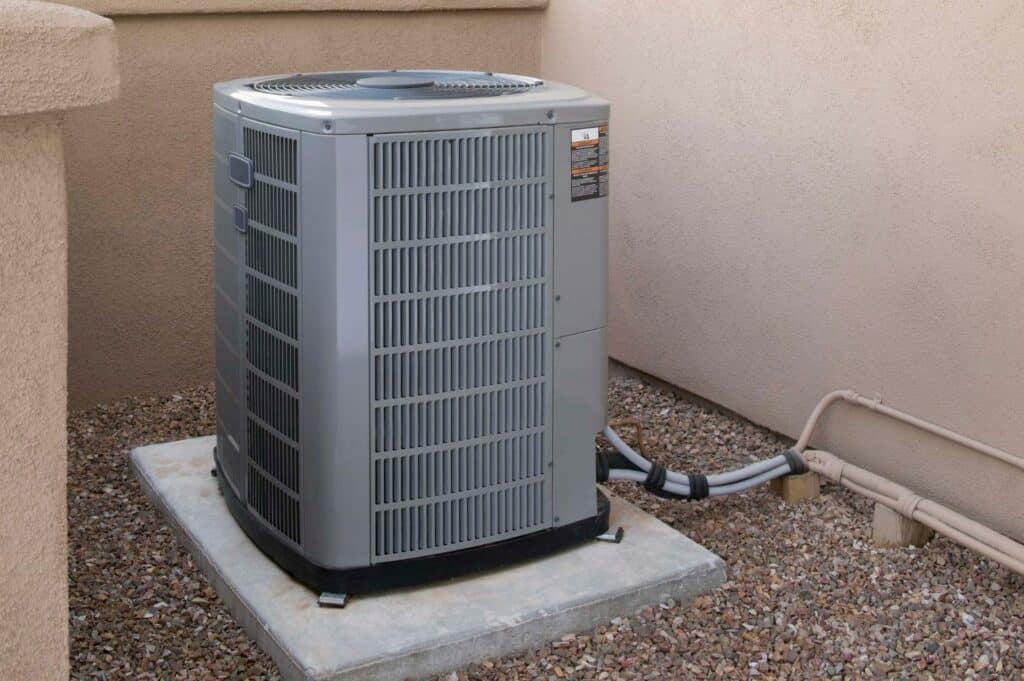
It is the most common cooling system and is found in many homes. This system cools the entire house at once; hence the bedroom and the kitchen will be at the same temperature. It has an external condenser unit outside the home that expels heat and an evaporator coil that cools the air in the house. It is usually integrated with the furnace system; hence it takes advantage of the furnace filter to clean the air in the home.
How Does A Central Air Conditioner Work?
A central air conditioner system has the following:
- An outdoor unit that has a condenser coil, fan, and compressor.
- A thermostat to control the temperature.
- An indoor unit that houses the fan and evaporator coil to circulate the cool air.
- An expansion valve that regulates the refrigerant going into the evaporator coil.
- A copper tubing to allow the refrigerant to flow between the two units.
- The ductwork allows air to circulate from the indoor unit to the indoor unit.
A central air conditioner system works in eight steps as follows:
- When the temperature exceeds that set on the thermostat, a signal is sent to the circuit board in the furnace.
- The signal tells the system that cold air is needed; hence the blower motor and the condenser are turned on.
- The warm air is then drawn into the ductwork and cooled over the evaporator coil.
- The cool air is then brought back to the home via the return air vents.
- While this happens, the refrigerant also absorbs heat from the air as it flows through the evaporator coil.
- The heated refrigerant is then pumped to the condenser.
- The condenser then blows the outside air through several coils, removing the heat that was absorbed by the refrigerant before the refrigerant travels back through the copper tubing back to the indoor unit.
- The process continues until the desired temperature is met.
Types Of Central Air Conditioners
A central air conditioner system has two types: a packaged unit or a split-system unit.
Split-System Unit

It consists of an outdoor metal cabinet that houses the compressor and condenser and an indoor cabinet with an evaporator. You will find that the indoor part also has a heat pump or a furnace in many types. This mini-split system is perfect if your home already has a furnace but no air conditioner installed.
The refrigerant circulates between the indoor unit where heat is absorbed and the outdoor one, where heat is expelled. The refrigerant then cools and dehumidifies the air, which is then circulated by the furnace blower throughout the house.
Packaged Unit
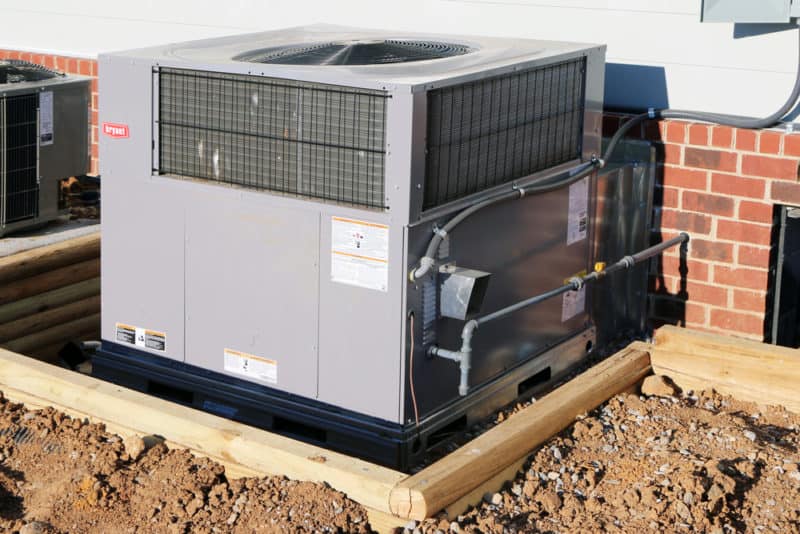
In many split-system units, you will find the condenser outdoors and the evaporator indoors. However, both components are in the same unit for the packed central air conditioner system, usually installed outside the home. The warm air in the house is pumped to the packaged unit outside the home, where it is then cooled and returned indoors. This unit is mainly used in small commercial buildings.
Advantages:
- They require little maintenance.
- They provide a consistent temperature.
- You will save costs on air conditioning units, as you will not have to buy separate AC s for each room.
- You can use a programmable thermostat, hence saving on cooling costs.
- They utilize air filters to clean air. Therefore, they decrease the airborne particles such as dust, dander, and pollen that you may breathe in.
Disadvantages
- They have high installation costs.
- They require air ducts.
- External units take up lots of space.
Central air conditioners are great if you have a large house with many rooms to be cooled. However, if you have a small apartment, they might not be the best option.
Ductless Mini Split System Air Conditioners
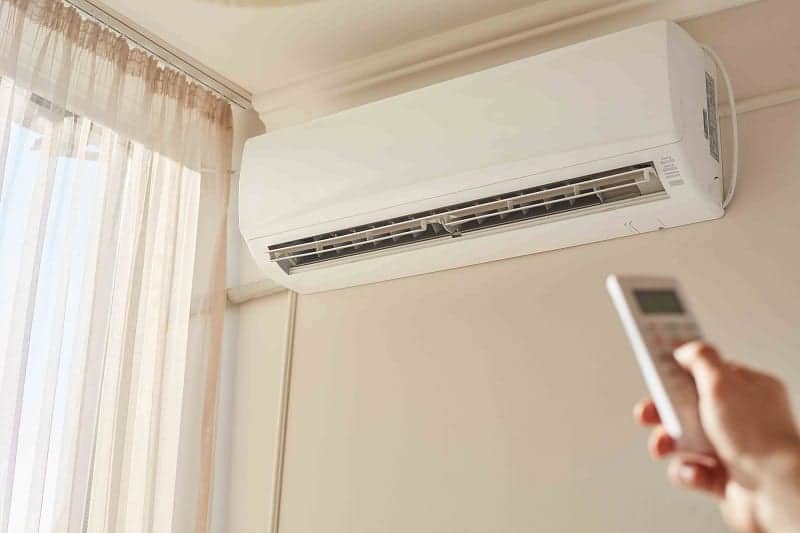
If your home does not have ductwork, then this is the perfect solution for you. Mini-split systems are also great for room additions. They have individual air handling units that are linked via a conduit to a single outdoor unit. Each air handler has a thermostat; hence you can maintain different temperatures in several rooms. The indoor air handlers can be mounted on walls or ceilings, whichever you prefer.
How Ductless Mini Split Systems Work
The indoor unit blows warm air from the house over the cold evaporator coils. The refrigerant then absorbs the heat from the air and takes it to the outdoor unit. This is where the refrigerant releases all the heat from the house.
Advantages:
- They require no venting.
- They can be installed easily and quickly with minimum disruption.
- They are efficient as there is no air loss as in ducted systems.
- They are ideal for single-use applications such as remodeled spaces and room additions.
- They are convenient as they come with remote controls to adjust the settings.
- Some large systems can support up to four air handlers, each having a thermostat.
- They can hang from a wall, ceiling or even be placed on the floor.
Disadvantages
- They have a 30% higher initial cost than a central system, excluding ductwork fees. This is because you will need to buy individual air handlers for every room of the house.
- Incorrectly positioned air handlers can result in short-cycling, which wastes energy.
- It is difficult to maintain the proper temperature and humidity level if there is a short-cycling problem.
Evaporative Cooling Systems
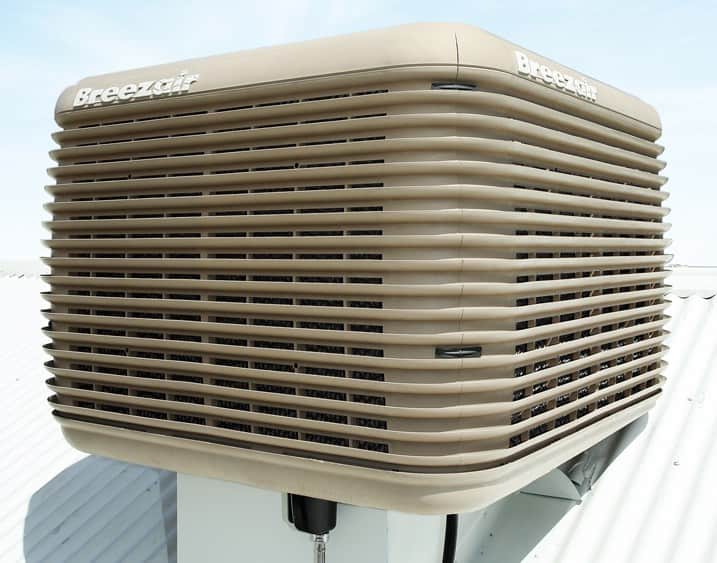
Also known as swamp coolers, these cooling systems work differently than the central air conditioners as they rely on dry air pulled from the environment. They are perfect for dry climates such as the Southwest regions of the United States and not areas with high humidity such as Florida. They are less expensive and more efficient than a central AC. Their cost-effectiveness is because the fan is the only electrical component, but they lose efficiency as soon as humidity rises.
How Evaporative Cooling Systems Work
These evaporative coolers use a fan to push air through moist pads and circulate cool air inside the house. It is then cooled by evaporation and released back to the house. The process produces air that is around 30 degrees cooler.
A direct evaporative cooler adds moisture, which is excellent, especially for dry climates. On the other hand, an indirect evaporative cooler has water evaporating on one side of the heat exchanger. The air from the house is then forced to the other side, where it only cools off but does not pick off moisture. It is crucial to note that they both lose their effectiveness as humidity increases, as the humid air cannot carry additional moisture efficiently.
Advantages
- They are environmentally friendly as they do not use refrigerants like CFCs and HCFCs.
- Direct evaporative coolers naturally add moisture to the home, keeping your fabrics and furniture from drying out.
- They do not need ductwork.
- The smaller units need little installation.
- They use less energy; hence they are pretty efficient.
- They filter air as they use moist pads, which trap pollen and dust.
- They can decrease the outside temperature by around 30 degrees Fahrenheit.
Disadvantages
- Moisture buildup could lead to corrosion and condensation.
- They are not favorable in humid climates as they add moisture to the air.
- They need monthly moisture pad maintenance.
- Roof deterioration may occur if they are installed on a roof. This happens due to the monthly maintenance checks.
- They continually need water; hence this can be an issue in areas with limited water supply.
When considering an evaporative cooler, consider the size of the home. This will determine the size of the cooler that you go for. A general rule of thumb is to divide the cubic square footage of your home by 2.
Heat Pumps
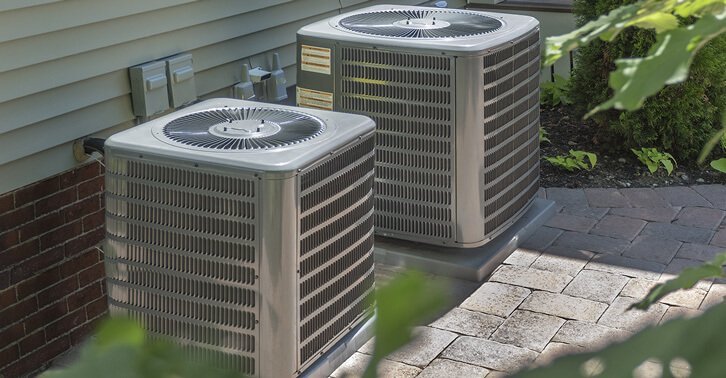
Most of the cooling systems that we have today are technically heat pumps. This is because they pump heat from one place to another. However, while an air conditioner will only move heat in one direction, a heat pump can be reversed and pump the heat in both directions. Therefore, it functions as an air conditioner and a heater; hence, you can use it to heat and cool the home all through the year, without using a furnace, unless it is freezing. Amazing, right?
They work as an air conditioner in the summer by pulling heat from the air and taking it outside. In winter, they extract warmth from the outdoor air or the ground, in the case of geothermal heat pumps, and condense it until it is hot enough to keep everyone warm. The furnace will take over when the outside temperatures get too cold for the heat pump to function effectively.
How Heat Pumps Work
Heat pumps function like an air conditioner, with the difference being that the AC process can be reversed to heat the home during winter. They use the same ductwork with a furnace fan to distribute the warm air in the house. The compressor moves the refrigerant through the system. The pressurized refrigerant is then taken to the coil in the outdoor unit. The heat pump has a reversing valve that reverses the refrigerant flow, which switches the system. It also has an accumulator that allows the system to adjust the refrigerant charge.
Types Of Heat Pumps
There are three different heat pumps: air-source central heat pumps, ductless split heat pumps, and geothermal heat pumps.
Air Source Central Heat Pumps
These are the most common types used in North America. They rely on ductwork to circulate air in the home. The pump has two primary units, just like an air conditioner; the condenser and evaporator coil. The refrigerant circulates between them, absorbing heat and releasing it outside, and vice versa, collecting heat from the outside and releasing it inside the house.
Ductless Split Heat Pumps
These can be installed in homes with no ductwork. They also have two units; an outdoor one containing a fan, compressor, condenser coil and an indoor unit with an evaporator coil and fan. One of the key advantages of these systems is that they are energy-saving compared to ducted systems. However, it can be pretty expensive to install several indoor units.
Geothermal Heat Pumps
These operate similarly to air-sourced heat pumps, except that they do not absorb and expel heat into the air but instead do so into the ground. This is why they are also referred to as ground-source heat pumps. Air-sourced heat pumps are cheaper and easier to install; thus, they are more common than geothermal heat pumps. However, the latter is more efficient and an excellent option for people who plan to stay in one place for many years.
Advantages
- They can be used to heat and cool the home.
- They save energy due to their high efficiency in milder weather.
- They run on electricity; hence they emit lower carbon dioxide emissions than a furnace that burns natural gas.
- Modern heat pumps come with an ecobee smart thermostat that automatically switches from the heat pump to the furnace when needed.
Disadvantages
- They have high installation costs.
- They can be pretty noisy.
- They require regular maintenance as central air conditioners.
Heat pumps are the perfect option for people looking to combine both heating and cooling systems. In addition, they will save you money in the long run on electricity bills.
Fans
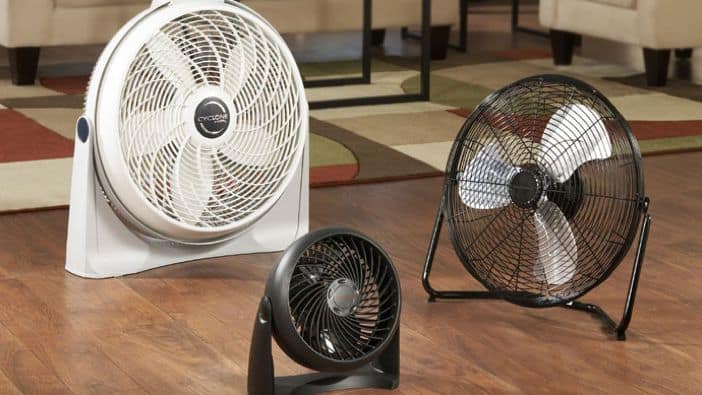
They are one of the most commonly used cooling systems in the market. Circulating fans include table fans, ceiling fans, floor fans, and those mounted on poles or walls. They create a wind-chill effect that will be an excellent addition to natural ventilation or air conditioning.
Ceiling fans are the most effective of the rest as they can effectively circulate air throughout the room, creating a draft. However, they are only appropriate in rooms with ceilings that are at least eight feet high, and their blades should be 10 to 12 inches below the ceiling and 7 to 9 feet above the floor.
How Fans Work
Fans, unlike air conditioning, do not cool the room but the occupants in it. The breeze from the fan cools the occupants by disrupting the stagnant air surrounding the body, hence preventing heat loss. This way, the removal of insulating air will make you feel more relaxed. Therefore, it is advised to turn off the fan when you leave the room, as it does not cool spaces, but people.
Advantages
- They can be used to keep you warm and also cool, depending on the climate.
- They are cost-effective when compared to the central air conditioners.
- They do not require as much energy as other cooling systems; hence they can lower your electricity bills.
- They do not emit harmful gases and pollutants as they are environmentally friendly.
Disadvantages
- They can only drop the temperature to a few degrees.
- They can be quite noisy based on the motors they use. Also, over time, the weight shifts, screws loosen, and blades move; hence they can be very noisy, especially in a quiet room.
Read also: How to Find the Best AC Motor Fans.
Tips For Cooling Your Home
Soaring temperatures can force us to blast the cooling systems, but this is always not the solution. Instead, there are some cooling tips that you can follow to cool the home efficiently and reduce your costs. They include:
Choose an energy-efficient system
When buying a cooling system for the home, ensure that it is ENERGY STAR certified. Cooling systems with this certification perform better as they have a higher seasonal energy ratio (SEER) and energy efficiency ratio (EER). These will also reduce your energy consumption, especially in summer.
Ensure regular maintenance is done
Most of us forget about our cooling systems until we notice a problem, but this should not be the case. To avoid this, book for a spring tune-up, as it will reduce your cooling costs by 10% and extend the system’s lifespan.
Upgrade your home’s thermostat

If you have been using a manual thermostat, this is the time to upgrade to a programmable or smart option. It will help you have control over the energy bill and the home’s temperature efficiently. In addition, smart thermostats will keep the house at the perfect temperature when you are away, which will be a plus for you.
Change or clean the furnace filters
Clogged filters hinder airflow and make the cooling systems work overtime. Therefore, ensure that you clean or change the furnace filters according to the manufacturer’s instructions.
Switch on the fans
Using fans will help reduce your bills and conserve energy. For example, you can use bathroom fans while showering and activate the range hood while cooking.
Seal the windows
Check for air leakage around the frames and joints of the windows regularly. You can use a leak detector to do this. Signs of damage to look out for include staining, rot, mold, and weather-stripping. Ensure that the windows are well-insulated and sealed to keep the air out.
Insulate the home
In-wall and in-roof insulation will help keep heat in and cool out in winter. Adding attic insulation is one of the easiest and cheapest ways to cool the home.
Open the vents
Contrary to what most people think, closing the vents will not save energy. This is because the AC will produce the same amount of air, whether the vents are open or closed. Therefore, closing them will increase pressure, which will strain the fan, affecting its lifespan. It will also use more energy in the process and cause the coil to freeze due to insufficient airflow. Therefore, it is better to open the vents than to close them.
Plant shade
One of the other ways to lower your bills is to plant tall trees or shrubs near your home. These will offer shade, hence reduce your AC costs, and improve the efficiency by 10%
Close the blinds
Windows can let in direct sunlight, which will heat your home, depending on its direction. Therefore, you can limit the sunlight by closing the curtains and blinds of the windows.
Our Top Recommendations
There are several things to look for when choosing a cooling system for your home. These include the installation costs, lifespan, warranties, size of the unit, and energy efficiency. Based on these, below are some of the cooling systems we love.
GE 250-sq Window Air Conditioner
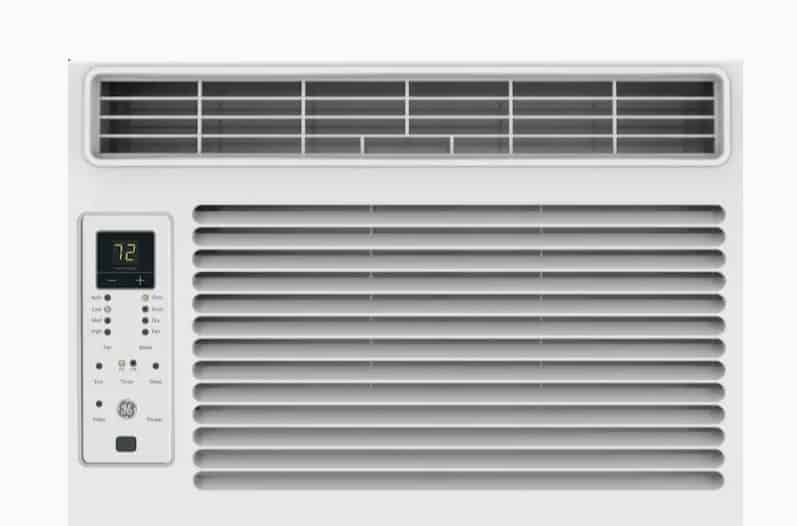
This air conditioner is perfect for single room needs, delivering an efficient cooling capacity of 6000BTU up to 250 square feet, with inexpensive installation. You can even mount it yourself using the EZ installation guide and chassis.
It also comes with a remote control that will help you adjust the thermostat accordingly. However, it is not ENERGY STAR certified, but it has an energy saver mode that will turn off automatically when the room is cool.
Whynter ARC-14SH Portable Air Conditioner
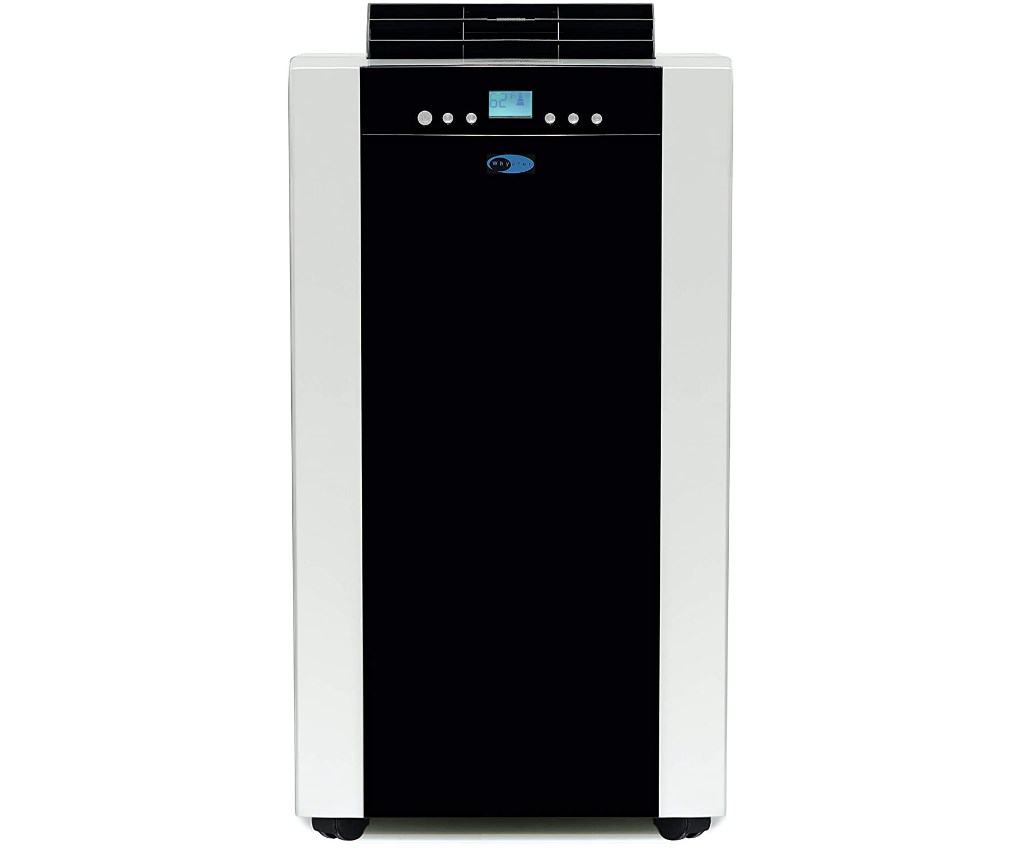
This air conditioning unit is perfect for large rooms up to 500 square feet. It can also be used in small apartments, as it is pretty flexible. If you want an environmentally friendly system, then this is your best bet.
It uses R32, a CFC-free refrigerant, which is safe for the environment. It can also act as a dehumidifier and has two filters, hence keeping your air quality clean for you and your family. In addition, it is a free-standing unit and does not take up much space, which will be great for you.
Rheem RP20 Econet Variable Speed Heat Pump
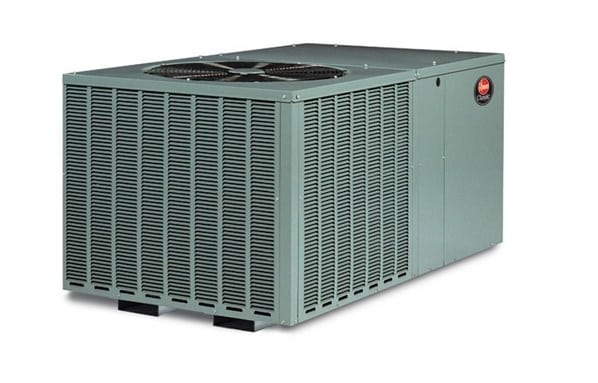
Rheem is the brand to look for if you want a system that will serve you all year long without any issues. Rheem heat pumps are perfect for both residential and commercial uses and come with numerous features.
For example, the RP20 Prestige series has a SEER of 20 and is ENERGY STAR qualified. They are also relatively easy to operate, which makes them quite efficient and reliable.
FAQs
Question: Is it time to buy a new central AC system?
Answer: Central air conditioners are an expensive investment and will serve you for around 10-12 years. However, if it lasts longer, it may be time to buy a new one to improve efficiency. Other signs that show that it is time to buy a new central AC system include:
Question: Your utility bills are increasing?
Answer: If your air conditioning-related expenses are going up and you have not made any changes, it may mean that the system is not as efficient as before. If you also note that you are constantly paying for repairs day in and day out, it is time to buy a new one.
Question: Comfortability?
Answer: If your family’s comfort is compromised, then buying a new central AC unit may not be a bad idea after all. Comfortability is crucial and should not be taken lightly.
Question: Excessive noise and dust?
Answer: If you notice that there is dust in the house, even after cleaning, then you might have leaks in the ductwork. If it is too noisy, then the duct system may not be big enough for the room or an issue with the indoor coil.
Question: It uses R-22 Freon?
Answer: On January 1st of 2020, the production of Freon was phased out by the federal government. Therefore, if your air conditioner uses Freon, you will have to replace it to switch to the R410 refrigerant.
Question: Is it healthy to sleep with a fan on?
Answer: Some people claim that sleeping with a fan helps them fall asleep faster while enjoying the cool breeze. But is it safe? Sleeping with a fan has its advantages and disadvantages.
The advantages include:
• Cooling effects on a hot night.
• Fans help circulate stale air and freshen the room.
• They also produce a hum that is similar to the sound of white noise hence helping you sleep.
• According to research, fans can lower the risk of sudden infant death syndrome in babies (SIDS).
The drawbacks include:
• Dry skin and eyes due to the fan’s air.
• Muscle aches.
• It can trigger allergies due to dust and pollen circulation.
• Congestion.
Sleeping with a fan has its pros and cons, and it will affect various people differently. However, if you suffer from allergies or asthma, it is recommended to use another cooling system.
Question: Is it safe to leave my AC running all day?
Answer: Leaving the AC on during the day is safe, and it will not lead to any fires or disasters in the house. Also, for some people, leaving the AC on is more efficient than turning it off in the morning and on back at night. This is because the latter will strain the AC and increase your electricity bills in the long run. A solution to this is to use a modern unit with programmable thermostats to do the job for you.
When it comes to choosing cooling systems, there is no correct answer on which one is the best for everyone. The choice depends on various factors, as seen above, to suit the needs of the home. With the above-detailed guide, you will be able to make an informed decision that your family will thank you for.
- The Best 2.5 Ton Heat Pump Guide: Which is Right for You? - December 9, 2023
- Furnace Flame Sensor Replacement Guide 101: How To Replace Your Furnace Flame Sensor - May 6, 2022
- The Best 6000 BTU Mini Split Options - May 5, 2022
